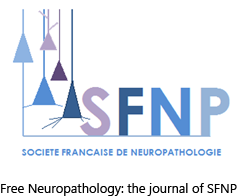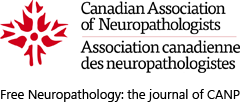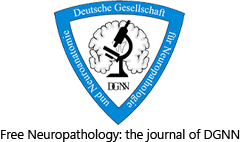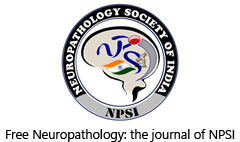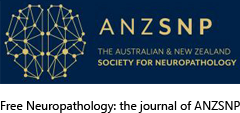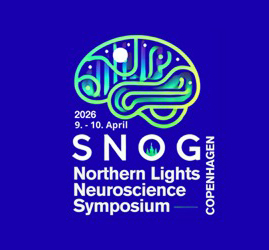Desmoplastic myxoid tumor of pineal region, SMARCB1-mutant, in young adult
DOI:
https://doi.org/10.17879/freeneuropathology-2021-3340Keywords:
Desmoplastic myxoid tumor, SMARCB1-mutant, Atypical teratoid/rhabdoid tumor, Pineal, CSF disseminationAbstract
We present a young adult woman who developed a myxoid tumor of the pineal region having a SMARCB1 mutation, which was phenotypically similar to the recently described desmoplastic myxoid, SMARCB1-mutant tumor of the pineal region (DMT-SMARCB1). The 24-year-old woman presented with headaches, nausea, and emesis. Neuroimaging identified a hypodense lesion in CT scans that was T1-hypointense, hyperintense in both T2-weighted and FLAIR MRI scans, and displayed gadolinium enhancement. The resected tumor had an abundant, Alcian-blue positive myxoid matrix with interspersed, non-neoplastic neuropil-glial-vascular elements. It immunoreacted with CD34 and individual cells for EMA. Immunohistochemistry revealed loss of nuclear INI1 expression by the myxoid component but its retention in the vascular elements. Molecular analyses identified a SMARCB1 deletion and DNA methylation studies showed that this tumor grouped together with the recently described DMT-SMARCB1. A cerebrospinal fluid cytologic preparation had several cells morphologically similar to those in routine and electron microscopy. We briefly discuss the correlation of the pathology with the radiology and how this tumor compares with other SMARCB1-mutant tumors of the nervous system.
Metrics
Additional Files
Published
How to Cite
Issue
Section
License
Copyright (c) 2021 Branavan Manoranjan, MD, PhD, Yves P. Starreveld, MD, PhD, Robert A. Nordal, MSC, MD, FRCPC, Christopher Dunham, MD, FRCPC, Susanne Bens, MD, Christian Thomas, MD, Martin Hasselblatt, MD, Jeffrey T Joseph, MD, PhD

This work is licensed under a Creative Commons Attribution 4.0 International License.
Papers are published open access under the Creative Commons BY 4.0 license. This license lets others distribute, remix, adapt, and build upon your work, even commercially, as long as they credit you for the original creation. Data included in the article are made available under the CC0 1.0 Public Domain Dedication waiver, unless otherwise stated, meaning that all copyrights are waived.








